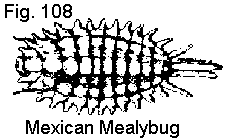Mexican Mealybugs
Return to: CFREC Home Page
Return to: Index
DESCRIPTION
Adult- The female Mexican mealybug
adult is 3 to 4 mm long, oval, grayish and covered with a thin
waxy secretion. There are three parallel rows of small waxy tufts
down the back. This insect is a short-tailed mealybug (the caudal
filaments do not exceed 1/4 the body length). The lateral
filaments are also short. Males are small gnatlike insects with
only two wings. Adult Mexican mealybug males have four waxy,
posterior filaments. Eggs- The egg sac is white, dense, narrow,
and longer than the female secreting it. Nymphs- The nymphs are
small and yellowish with white waxy secretions.
 Fig. 108: Mexican mealybug, Phenacoccus
gossypii Townsend and Cockerell, Pseudococcidae,
HOMOPTERA
Fig. 108: Mexican mealybug, Phenacoccus
gossypii Townsend and Cockerell, Pseudococcidae,
HOMOPTERA
Adult female. Closely related mealybugs: Phenacoccus
madeiresis Green  ZOOM
ZOOM
Phenacoccus solani Ferris  ZOOM
ZOOM
Unknown species  ZOOM
ZOOM
To see pictures of the damage casused by this mealybug click HERE!
BIOLOGY
Distribution- From Mexico the mealybug
has spread throughout the United States, Hawaii, Cuba, and Puerto
Rico. It survives in greenhouses and on houseplants in temperate
climates and outdoors in subtropical areas of the United States.
Host Plants- The Mexican mealybug is found commonly on numerous
ornamental plants, a few of which are aralia, chrysanthemum,
English ivy, geranium, Gynura, hollyhock, Ixia, lantana, and
poinsettia. This insect is also a minor pest of lima beans in the
warmer parts of the United States. Damage- Wilting and stunting
are common symptoms of Mexican mealybug attack. This insect can
be as damaging as the citrus mealybug. The mealybugs and ovisacs
also disfigure heavily infested plants. Life History- In the
greenhouse, the Mexican mealybug may have seven complete
generations in one year. The average time required from
oviposition to the adult stage is 47 days. Each female deposits
about 400 eggs. The eggs are enclosed in an elongate cottony mass
called the ovisac that originates at the back of the female. The
ovisac is about 6 mm long. The eggs hatch in 6 to 14 days. The
life cycles of the male and female Mexican mealybugs differ. A
female passes through three nymphal stages only. Male Mexican
mealybugs pass through two nymphal stages and two resting stages
(prepupal and pupal stages). Normally, these mealybugs are found
above ground on the leaves, stems or flowers, but occasionally
will be found feeding on the roots.
CONTROL
For chemical control recommendations, see the current
Cooperative Extension publications on ornamental plant pest
management or consult your county Extension agent.
University of Florida/IFAS Reference
to Pest Control Guides
 Fig. 108: Mexican mealybug, Phenacoccus
gossypii Townsend and Cockerell, Pseudococcidae,
HOMOPTERA
Fig. 108: Mexican mealybug, Phenacoccus
gossypii Townsend and Cockerell, Pseudococcidae,
HOMOPTERA  Fig. 108: Mexican mealybug, Phenacoccus
gossypii Townsend and Cockerell, Pseudococcidae,
HOMOPTERA
Fig. 108: Mexican mealybug, Phenacoccus
gossypii Townsend and Cockerell, Pseudococcidae,
HOMOPTERA ![]() ZOOM
ZOOM ![]() ZOOM
ZOOM ![]() ZOOM
ZOOM